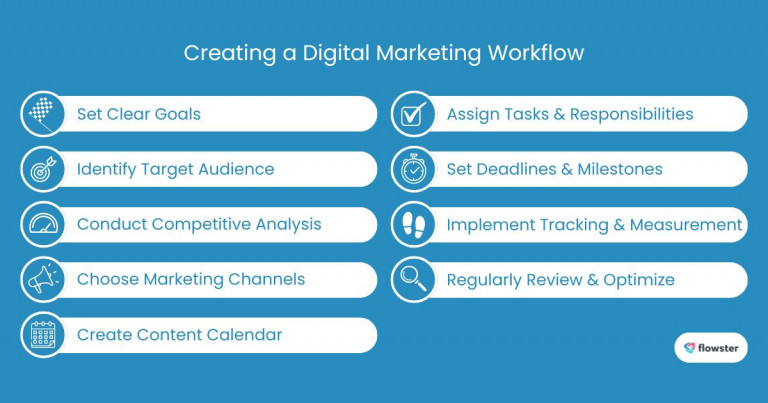In today’s fast-paced digital landscape, a well-structured digital marketing workflow is essential for achieving success. A haphazard approach to marketing can lead to wasted resources, missed opportunities, and inconsistent results.
A digital marketing workflow serves as a roadmap, guiding your marketing efforts and ensuring they align with your overall business goals. A marketing agency for contractors can help craft the best digital marketing workflows for optimal results.
A digital marketing workflow is a systematic process that outlines the various tasks, strategies, and channels involved in promoting a brand or product online. It encompasses a wide range of activities, including SEO, social media marketing, content marketing, email marketing, PPC advertising, analytics, and data-driven marketing. By establishing a clear and efficient workflow, you can streamline your marketing efforts, improve collaboration among team members, and measure the effectiveness of your campaigns.
Article Outline
What is a Digital Marketing Workflow?
A digital marketing workflow is a strategic plan that outlines the steps and processes involved in executing a successful online marketing campaign. It serves as a roadmap, guiding your team through the various tasks and responsibilities required to achieve your marketing objectives.
Why is a well-structured workflow crucial for effective digital marketing?
- Improved efficiency: A clear workflow helps you avoid duplication of efforts, streamline tasks, and allocate resources more effectively.
- Enhanced collaboration: By defining roles and responsibilities, a workflow fosters better communication and collaboration among team members.
- Better decision-making: A structured workflow provides a framework for analyzing data, tracking progress, and making informed decisions.
- Increased accountability: By outlining specific tasks and deadlines, a workflow helps ensure that everyone is accountable for their responsibilities.
Flowster's AI-Driven Automation
What are the essential components of a digital marketing workflow?
A typical digital marketing workflow includes the following key elements:
- Goal setting: Clearly define your marketing objectives and align them with your overall business goals.
- Target audience identification: Identify your ideal customer and understand their needs, preferences, and behaviors.
- Competitive analysis: Assess your competitors’ strategies and identify opportunities for differentiation.
- Strategy development: Create a comprehensive marketing strategy that outlines the tactics and channels you will use to reach your target audience. However, first get a better idea of what is digital strategy, as it can help improve your approach.
- Content creation: Develop high-quality content, such as blog posts, articles, videos, and infographics, that resonates with your target audience. Marketers can also repurpose blog content into audio formats using a TTS API, making material more accessible to busy audiences or those with visual impairments.
- SEO optimization: Optimize your website and content for search engines to improve visibility and organic traffic. You can also use organic seo services to help boost rankings naturally, without relying on paid ads, by focusing on quality content and strong on-page practices.
- Social media marketing: Leverage social media platforms to engage with your audience, build brand awareness, and drive traffic to your website. Use social listening tools to monitor conversations, understand audience sentiment, and tailor your content strategy based on real-time feedback.
- Email marketing: Build and nurture your email list to send targeted and personalized communications.
- PPC advertising: Utilize paid advertising platforms like Google Ads and Facebook Ads to reach your target audience quickly and effectively.
- Analytics and reporting: Use an ad tracker to monitor key performance indicators (KPIs), measure campaign success, and identify areas for improvement.
By understanding the components of a digital marketing workflow, you can create a more structured and effective approach to your online marketing efforts. In the next section, we will discuss how to create a digital marketing workflow tailored to your specific needs.

Creating a Digital Marketing Workflow
Developing a customized digital marketing workflow is essential for aligning your efforts with your business objectives. By following a structured process, you can ensure that your marketing activities are efficient, effective, and measurable.
Here’s a step-by-step guide to creating a digital marketing workflow:
- Set clear goals: Define your marketing objectives and align them with your overall business strategy. Consider factors such as increasing brand awareness, generating leads, driving sales, or improving customer satisfaction.
- Identify your target audience: Understand your ideal customer’s demographics, preferences, and behaviors. This information will help you tailor your marketing messages and choose the most effective channels to reach them.
- Conduct a competitive analysis: Assess your competitors’ digital marketing strategies and identify areas where you can differentiate yourself. Look at their website, social media presence, content marketing efforts, and paid advertising campaigns.
- Choose your marketing channels: Determine which channels are most relevant to your target audience and align with your marketing goals. Consider options such as search engine optimization (SEO), social media marketing, content marketing, email marketing, pay-per-click (PPC) advertising, and influencer marketing.
- Create a content calendar: Develop a content calendar outlining the topics, formats, and publication dates for your content. This will help you stay organized and ensure a consistent flow of content.
- Assign tasks and responsibilities: Clearly define roles and responsibilities within your team. Assign tasks based on individual skills and expertise, and ensure that everyone understands their role in the workflow.
- Set deadlines and milestones: Establish realistic deadlines for each task and milestone within your workflow. This will help you stay on track and avoid delays.
- Implement tracking and measurement: Choose key performance indicators (KPIs) to measure the success of your marketing campaigns. Track metrics such as website traffic, leads generated, conversion rates, and social media engagement. Additionally, using an LLM visibility tool can help you track how often your content or brand is referenced in AI-generated responses, providing deeper insights into customer behavior and uncovering opportunities to enhance your visibility across various channels.
- Regularly review and optimize: Continuously monitor your workflow and make adjustments as needed. Analyze your data to identify areas for improvement and optimize your strategies accordingly.
When creating your digital marketing workflow, consider the following key factors:
- Resources: Assess the resources available to you, including budget, personnel, and technology.
- Timeline: Set realistic timelines for your marketing activities, taking into account the complexity of each task.
- Flexibility: Build flexibility into your workflow to accommodate changes and adapt to evolving trends.
- Collaboration: Foster collaboration among team members to ensure a cohesive and effective marketing approach.
By following these steps and considering the key factors outlined above, you can create a digital marketing workflow that is tailored to your specific needs and helps you achieve your business goals. In the next section, we will discuss some free digital marketing workflow templates that can help you get started.
Free Digital Marketing Workflow Templates
A well-structured digital marketing workflow can significantly improve the efficiency and effectiveness of your online marketing efforts. While you can create your own workflow from scratch, using a pre-built template can save you time and ensure that you’ve covered all the essential elements.
Marketing Agency Client Onboarding Template
Streamline your client onboarding process with this free, customizable template. Pre-filled sections, interactive elements, and simple editing make it a breeze to use. Start now! (Click anywhere in the template)
By using a free digital marketing workflow template, you can get started quickly and ensure that your workflow is well structured and comprehensive. In the next section, we will discuss some best practices for creating and managing a digital marketing workflow.
Best Practices for Digital Marketing Workflows
A successful digital marketing workflow requires more than just a well-structured plan. It also involves following best practices to ensure that your efforts are effective, efficient, and adaptable.
- Flexibility is key in a digital marketing workflow. The digital landscape is constantly evolving, and it’s important to be able to adapt your strategy as needed. This might involve adjusting your target audience, changing your marketing channels, or modifying your messaging.
- Collaboration is another essential component of a successful digital marketing workflow. By working together, team members can share ideas, identify opportunities, and ensure that everyone is aligned with the overall strategy. This can lead to more creative and effective marketing campaigns.
- Finally, tracking performance metrics and optimizing your workflow based on data insights is crucial. By measuring the success of your marketing activities, you can identify areas for improvement and make data-driven decisions. This can help you maximize your ROI and achieve your marketing goals.
By following these best practices, you can create a digital marketing workflow that is flexible, collaborative, and data-driven. In the next section, we will conclude our discussion and summarize the key points covered in this blog post.
Capture Your Processes in Minutes!
Conclusion: Creating a Successful Digital Marketing Workflow
In conclusion, a well-structured digital marketing workflow is essential for achieving your online marketing goals. By following a systematic process and incorporating best practices, you can streamline your efforts, improve collaboration, and measure the effectiveness of your campaigns.
Key takeaways from this blog post include:
- The importance of defining clear goals and understanding your target audience.
- The need for a comprehensive digital marketing strategy that encompasses various channels and tactics.
- The value of creating a content calendar and assigning tasks and responsibilities within your team.
- The significance of tracking performance metrics and optimizing your workflow based on data insights.
By implementing the principles discussed in this blog post, you can create a digital marketing workflow that drives results and helps your business succeed.
Ready to create your own digital marketing workflow? Check out Flowster Marketplace for a wide selection of free workflow templates that can help you get started.




